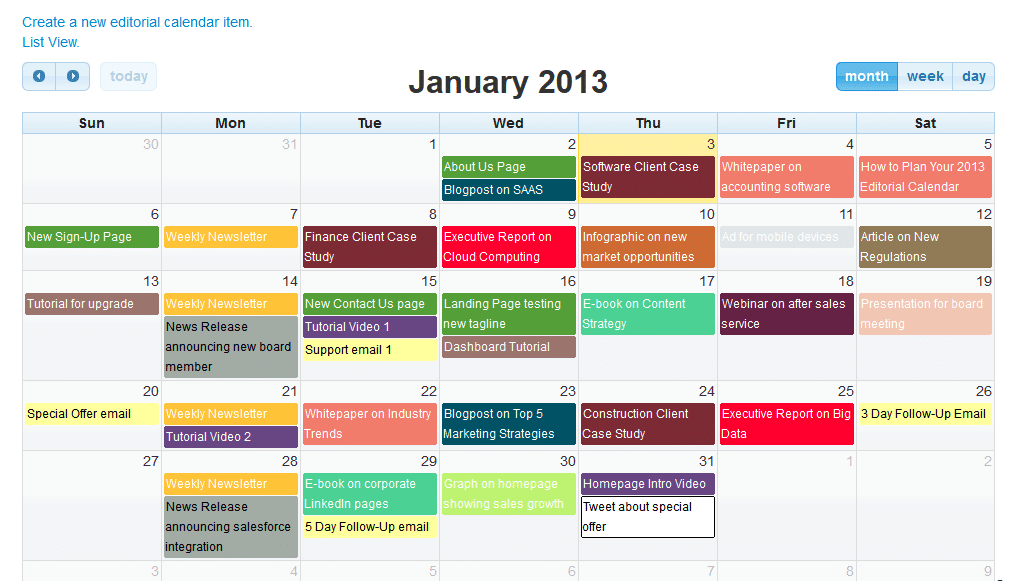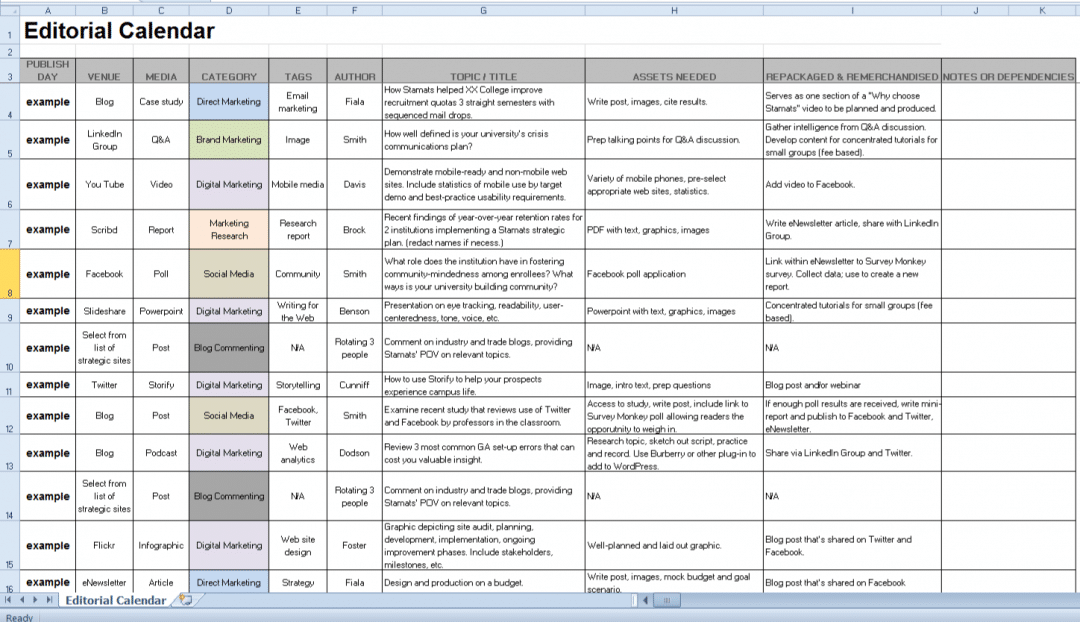The editorial calendar is frequently utilized by professional writers, marketers, businesses and various groups of specialists to manage their material across different kinds of press, for example papers, journals, weblogs, emails and social media sites.
An editorial schedule no longer represents a useful tool only for authors in mass media and publishers, but these days it is a system of which specialists and promoters in online media take advantage of all the time when trying to deliver high quality content and that will bring involvement from their readers. Composing new and interesting material for the countless websites and blogs found on the Internet is about creation and imagination, but it also demands a lot of strategic planning.
There are plenty of online systems to schedule these types of operations, and they allow you to have a good strategy and evaluate your editorial routine. Before you spend money on some of the paid software on the market, we suggest starting with an offline program that can be already found in your computer, such as Microsoft Excel or, if you prefer to store your documents in the cloud systems, use Google Docs, an online platform known for its versatility and user-friendly interface.
Editorial calendars are used to determine and manage the procedure of creating material, from a simple idea and all the way through composing and publishing it.

A person or small company will generally follow these steps in the publishing process:
- Discuss the main concepts of the material that will be published, where and when to submit it;
- Create each part of the respective material in accordance with the editorial calendar;
- Edit every part of the content;
- Publish every part of the material.
A larger team of people involved in a major project will adhere to the following publishing procedure:
- Discuss material and concepts based on which to create the content, where and when to publish it; make some back-up material items for every part of the respective content; plan schedules to determine whether to cancel or delay a certain material (for instance, if an editor becomes unavailable or a certain subject cannot be analyzed at the moment);
- Allocate each part of material in accordance with the publishing schedule;
- Create each part of the content;
- Evaluate the initial drafts of various parts belonging to the content;
- Make a decision depending on the initial draft and other requirements (then modify the publishing routine as necessary);
- If the feedback is positive, finish writing every part of the material and send the respective draft to the layout specialists so they will plan their graphic procedure;
- Perform the last edit, grammar and spelling checking, fact checking and rewriting if necessary;
- Submit parts of the material for review by law specialists;
- Make modifications if/as required depending on their opinions;
- Submit parts of the material to layout editors for their procedure consisting of visual elements that have to be included in the published material;
- Post material on a development/testing server and implement other changes if needed;
- Publish material on the production server and other media.
Regardless of the complexity of the publishing procedure, the activity is direct and repetitive. Publishers experience and cross a variety of obstacles before a part of their material appears on paper, on a blog or website, or on major social media platforms.
The details involved and monitored in the editorial calendar are based on the steps needed for posting material in a publication or in media, as well as what posts should be tracked. Too little or too much information make an editorial calendar hard to keep updated and used. Some remodeling of various article schedule elements, while following the calendar to post material, is necessary before it can be utilized.

When you are creating an editorial calendar template, it is a good idea to take into consideration some of the aspects listed below:
#1 Dates & Publishing Schedule
Usually, any type of material is written and arranged according to a certain day of the month when it will be published, this being an easy method to list all posts and monitor their level in the writing and editing procedure. Make a brief research regarding which is the most essential element to show in your calendar-draft, modification schedules, publishing or submitting time frame, etc. – and in doing so, you will be assured that no steps in the entire editorial procedure are missed.
#2 Author Rotations
Smart content publishers use the services of specialized writers to help them reduce the burden of frequent writing. They have to also be included in the editorial calendar with an online system or another similar service, so that everyone knows their writing objectives and work deadlines.
It is also a good idea for these writers to see exactly when their content will be posted, in case they want to share materials with their friends on public networking sites. You can consider including a line or observation to keep a list with the payments of your hired writers and your editorial price range.

#3 Topics & Assignments
In a similar manner to the authors’ rotations, describing who is accountable for certain stages of the procedure is essential to any editorial calendar. This section could show who needs to do the necessary modifications of the content, who has to begin writing a new material and who has the responsibility of posting the final material.
#4 Setting Performance Standards
To make an editorial calendar even more efficient and accurate, add to it some lines to monitor the performance of each one of your pieces of content, regardless of where and when they were published. Statistics you could collect data about consist of social media sharing percentage, the amount of page views and comments, along with their ratio of positive/negative reviews. This also simplifies the frequent reporting procedure, enabling you to simply crunch the final numbers instead of having to repeatedly gather the data every time you need them.
#5 Audience and Market Segmentation
Your material has to be addressing to a certain segment of public and marketplace through thematic writing and a particular call-to-action. Summarize those objectives in your editorial calendar, so that you will keep track of a subject or segment of viewers that do not receive new and interesting material as frequently as others.
#6 Diversity of Online Content
Whether you create material for a website, e-blog, podcast, eBook or for a combination of other means of content publishing, create a section for each part of your materials, so nothing is left off or neglected on the way. You might not study every portion of the content reviewed everyday – or every week – but it is a wise decision to show all of them in a descriptive graph, so you can successfully make your own strategy and plan your material over time.
#7 Social Media Editorial Calendar
Another step in almost every type of materials published on the Internet or in offline environments is how to advertise them on the social media platforms, given their huge influence today. Based on the subject, certain content might not be appropriate for all public networking systems and their audience. Or it could work for all of them, but it needs a different delivery depending on the segments of users. Adding “checkboxes” to your readers and potential clients guarantees that you will not leave some of them uninformed by mistake.

#8 General Comments
Despite listing all the other sections in this article, creating a specific area for comments, feedback and reviews allows to record details about a particular part of your material. Maybe a short article contradicts another one of your previous materials, but there is not the necessary time in the current routine to see what is the problem with both articles. Or maybe one of your specialists responsible for the editing procedure is going on vacation. A brief comment area allows keeping all technicalities in check.
The key to a good PR plan is that the schedule must fit the preparing necessities of your business. Going deliberately into an unpleasant procedure will just result in resources that are abandoned down the line. Be versatile with your editorial routine and modify it as you consider improving your writing procedure.
Publishers extract information from an editorial calendar and create a database that is openly available to entice promoters that might be interested in their work. Advertising professionals also take advantage of these shortened editorial schedules when they are trying to create a positive selling experience for their potential clients. But, the primary objective of an editorial calendar is to manage the publication of material to make sure there is a frequent appearance of various articles that interest visitors and promoters.
Traditional print specialists have used these editorial calendars in one form or another for a long time, this allowing them to control better the printing of books, publications and other type of content on paper. The modern days of the Internet have considerably increased the variety and number of marketers who have to arrange their material and make sure that all planned content is released at the scheduled time.


You’ve got it in one. Co’dnlut have put it better.